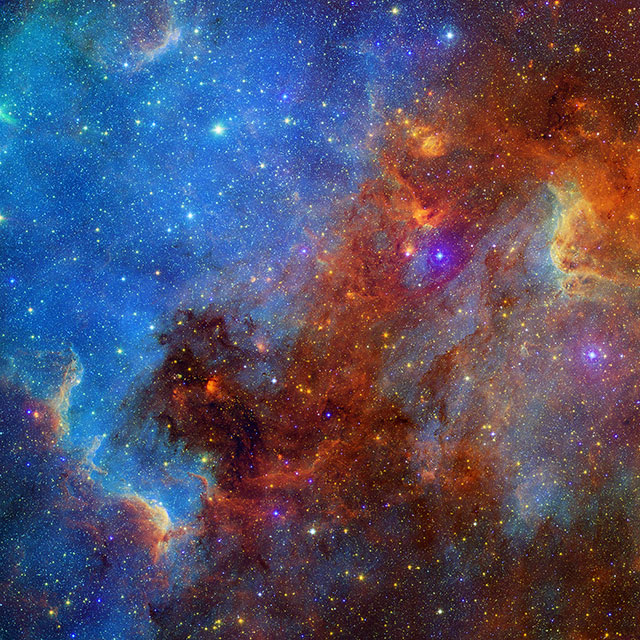
The Spitzer Telescope launched 16 years ago, in August 2003. To celebrate its sweet 16, NASA has shared 16 of the most beautiful space images captured by the infrared telescope.
In the image above, blue hues represent visible light, while red and green represent infrared light.

Zeta Ophiuchi is an enormous star which creates epic solar winds. The winds are so strong that they create shock waves, which you can see in reddish-orange, radiating out from the star.

This beautiful cluster is the Seven Sisters, also known as Pleiades, and is a favorite target among amateur astronomers.

In the Rho Ophiuchi nebula you can see baby stars being born beneath a blanket of dust. The dust is essential for star formation — it’s what gravitates together to form clumps and then, eventually, stars.

The striking Helix nebula is all that remains of a star that was once like our Sun. When the star died, it gave off gases which form the nebula around the hot core of the star, known as a white dwarf.

Glowing bright in the center of this image is the star Eta Carinae, which at 100 times the mass of the sun is one of the most massive stars in our galaxy.

This charmingly shaped object is known as the Sombrero galaxy for obvious reasons. From earth we see it edge on, which is why it appears so wide and short.

The galaxy Messier 81, on the other hand, we see much more face-on. The dust in this image is particularly visible, glowing pink as it is illuminated by forming stars.

More young stars are active in Messier 82, known as the Cigar galaxy due to its shape. With visible light, the galaxy looks long and thin. But in Spitzer’s infrared image, it glows with red clouds of dust.

Unlike the other images which Spitzer captured using infrared light, this image of the Pinwheel galaxy is composed from visible light, ultraviolet, and X-ray images from Hubble, the Galaxy Evolution Explorer’s Far Ultraviolet detector (GALEX), and the Chandra X-Ray Observatory as well as Spitzer’s infrared data.

Another composite image, this shows ripples in the Cartwheel galaxy (the blue, green, and purple ring) caused by the collision of two galaxies.

The famous Orion nebula is a favorite location to image for both Spitzer and Hubble, and combining data from the two telescopes shows the many details of the swirling gas.

More illuminated dust is visible in this image of the Spider nebula, created using data from Spitzer and the Two Micron All Sky Survey (2MASS).

The heart of our galaxy is a bustling hub of activity, as shown in this image of the Sagittarius constellation.

One of our galactic neighbors, the Large Magellanic Cloud, is captured in infrared to show its sea of dust.

In this image of the Cepheus C and B regions, a gas nebula glows green and orange, while the red tip of the nebula is an active area with bright stars giving off radiation and heating the gas until it glows.
Editors' Recommendations
- Swatch lets you put a stunning Webb space image on a watch face
- James Webb Space Telescope fully aligned and capturing crisp images
- James Webb Space Telescope has gone cold, but that’s good
- James Webb Space Telescope team delivers best possible news
- SpaceX birthday video celebrates its first 20 years



